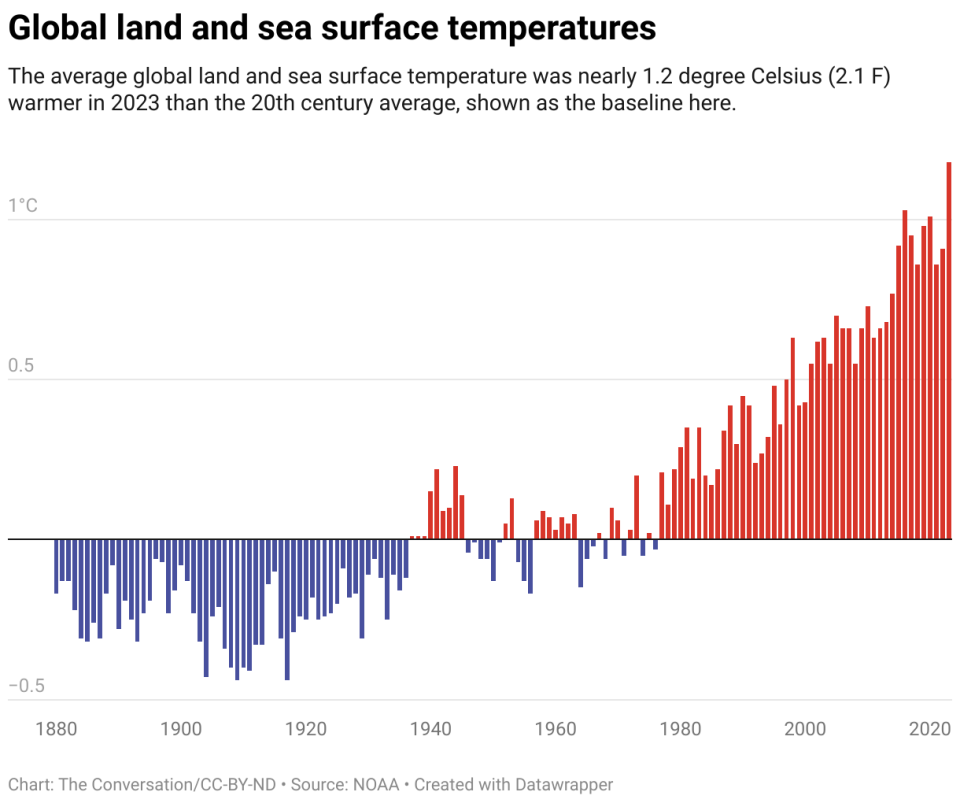One of the most robust measurements of the Earth’s changing climate is that winter is warming faster than other seasons. The array of changes it has brought, including ice storms and rain in regions that were once well below freezing, are symptoms of what I call the “warming winter syndrome.”
Winter warming represents global heat accumulation. During the winter months, direct heat from the Sun is weak, but storms and changes in the jet stream bring warm air from more southern latitudes into the northern United States and Canada. As global temperatures and oceans warm, stored heat has an impact on both temperature and precipitation.
The warming is evident in changes in growing seasons, reflected in recent updates to plant hardiness zones printed on the back of seed packets. These maps show the movement of freezing temperatures northward and sometimes westward across eastern North America.
This shifting of the freezing line between snow and rain could mean ice storms in places and at times when communities are not prepared to handle them, as seen in early 2024 in several parts of the United States.
Ice storms and wet snow
I study the impact of global warming and have documented changes in climate and weather conditions for decades.
Freezing temperatures, on average, move northward and into the interior of the continent along the Atlantic coast. For individual storms, the transition to freezing temperatures even in the dead of winter can now occur as far north as Lake Superior and southern Canada; In these places, it was reliably below freezing from early December to February 50 years ago.
When the temperature approaches freezing, the water can become rain, snow or ice. Areas on the cold side that have historically been below freezing and snowy are seeing an increase in ice storms.
The character of the snow also changes in places close to the freezing line. Snow becomes dry and fluffy when the temperature drops well below freezing. Near-freezing snow has large, wet, heavy flakes; These flakes turn roads into slush, stick to tree branches, and bring down power lines.
Individual snowstorms can also cause heavier snowfall, as the climate in which snowstorms occur is warmer due to global heat accumulation and wetter due to more evaporation and warmer air that can hold more moisture. However, as temperatures increase in the future, the scales will tilt towards rain and the total amount of snow will decrease.

Indeed, on the warmer side of the freezing line, winter rains are already becoming the dominant type of precipitation, and this trend is expected to continue. With warm oceans being the main source of moisture, more winter precipitation can be expected over the next 30 years in the already wet Eastern US. Looking ahead, wet and rainy winters are more likely to occur.
Disaster and water planning becomes more difficult
Planning for water resources and extreme weather for communities becomes even more complex in rapidly changing climates. Planners cannot count on the weather in 30 years to be the same as the weather today. It’s changing very fast.
In many places, snow won’t last until late spring. In regions that rely on snowpack for water year-round, such as California and the Rocky Mountains, these sources will become less reliable.
Rain falling on snowpack can also accelerate melting, trigger flash flooding and alter the flows of streams and rivers. This is manifested in changing flow patterns in the Great Lakes and led to flooding on the East Coast in January 2024.
For road planners, the rate of freeze-thaw cycles that can damage roads will increase during the winter months in many regions unaccustomed to such rapid changes.
A particularly interesting effect occurs in the Great Lakes. Already the Great Lakes are not freezing as early or completely as they used to. This has major impacts on the famous lake effect rainfall areas.
Since the lakes do not freeze, more water evaporates into the atmosphere. In places where temperatures are still below freezing during the winter, lake effect snow increases. The Buffalo, New York area saw 6 feet of snow from a lake-effect storm in 2022. As air temperatures flirt with the freezing line, these events are more likely to be rain and ice than snow.
These changes do not mean that the cold is completely over. There will be situations where Arctic air descends toward the United States. This can cause flash freezing and fogging when warm wet air rises back above the frozen surface.
Huge consequences for economies
What we experience in the warming winter syndrome is a consistent and powerful set of symptoms on a fiery planet.
November and December will be milder; February and March will be more like spring. Winter weather will become more intense around January. There will be unusual variations in snow, ice and rain. Some might say these changes are great; There is less snow to shovel and heating bills are decreasing.
But on the other hand, entire economies are geared to the winter season; Many crops depend on cold winter temperatures, and many farmers rely on freezing weather to control pests. Every time there is a change in temperature and water, the conditions in which plants and animals will thrive also change.
These changes, affecting outdoor sports and recreation, commercial fishing, and agriculture, have huge consequences not only on ecosystems, but also on our relationship with them. In some cases, traditions such as ice fishing will be lost. In general, people almost everywhere will have to adapt.
This article is republished from The Conversation, an independent, nonprofit news organization providing facts and analysis to help you understand our complex world.
Written by: Richard B. (Ricky) Rood, university of michigan.
Read more:
Richard B. (Ricky) Rood receives funding from the National Oceanographic and Atmospheric Administration (NOAA).